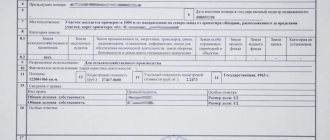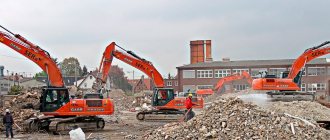Cadastral registration: features of the procedure
Share on social networks:
Any piece of real estate is unique in the eyes of the state. Therefore, it keeps strict records of all diverse objects. An existing element of real estate, land or water, country cottage, commercial, residential or industrial facility, must be noted in the state inventory. cadastral registration does .
Cadastral registration: features of the procedure
Registration of a plot/object for cadastral registration occurs according to a clearly established scheme. A cadastral engineer is invited to draw up a plan for a house, plot, apartment, etc. He:
- coordinates the boundaries to establish the exact boundaries, area, size of the object;
- develops a boundary plan, consisting of text and graphic context, determining the full cost of the object, the amount of subsequent land tax;
- prepares a technical plan reflecting the purpose, characteristic features of the object, location address;
- draws up an inspection report for decommissioned facilities.
In addition to the real estate plan, the owner must submit an application to Rosreestr for registration, a copy of the document regulating the right of ownership of real estate, and the assignment of the plot to a certain land category.
What is the Bureau of Cadastral Engineers
The main governing document in the field of cadastral activities is Law No. 221-FZ. It contains the definition of “cadastral engineer” - a citizen who is a member of the SRO of cadastral engineers. This specialist can work independently or in organizations of various legal forms. Companies that unite engineers can be represented as:
- architectural and cadastral bureau;
- land cadastral bureau;
- interregional or regional bureau of cadastral engineers;
- cadastral company.
This is not a complete list of names that you can find on the cadastral services market. There is no fundamental difference between them, since all engineers have the same powers, rights and responsibilities. Moreover, engineers can work in BTI or other organizations that bring together specialists and experts in many areas. For example, the staff of our company includes not only cadastral engineers, but also planners, surveyors, architects, designers, and experts. This allows us to provide the most complete range of services to customers, performing all the work independently and without intermediaries.
Dear Clients!
The information in this article contains general information, but each case is unique. You can get a free consultation from our engineers using one of our telephone numbers - call:
8 Moscow (our address)
8 St. Petersburg (our address)
All consultations are free.
Expert commentary. To engage in cadastral activities, an engineer must not only become a member of the SRO. In Art. 29 of Law No. 221-FZ specifies a number of additional requirements for specialists. They are required to pass a theoretical exam, receive a qualification certificate, confirm that they have no criminal record and have a higher education. You can become an engineer only if you have at least two years of experience working as an assistant while performing cadastral work.
Cadastral work includes measurements of the building inside and outside, determining the location of the building on the site.
Laws, orders, by-laws on cadastral activities
All areas of activity in the field of cadastre are described in laws and regulations. Let us highlight the main guiding documents that engineers use in their work:
Get an estimate of the cost of this service using our price calculator - here
- Law No. 221-FZ () - describes the basics of cadastral activities, requirements for specialists and organizations, main types of work;
- Law No. 218-FZ () - contains requirements for documents used for accounting and registration in Rosreestr (most of these documents are prepared by an engineer);
- Order of the Ministry of Economic Development No. 953 () - describes the rules for preparing and filling out the technical plan (this is a document with the characteristics and coordinates of the capital construction project);
- Order of the Ministry of Economic Development No. 921 () - regulates the procedure for drawing up and requirements for the content of the boundary plan (this is a document with the characteristics and coordinates of the sites);
- Order of the Ministry of Economic Development No. 861 () - describes the procedure for drawing up an inspection report (it is needed to deregister an object that has lost its existence).
This is a basic, but far from complete list of regulations that guide the bureau of cadastral engineers and the specialists themselves. Also, on certain issues in the field of cadastre, regional authorities can accept their documents.
| No. | Areas of activity of the bureau of cadastral engineers | Description |
| 1 | Land surveying, preparation of boundary plans | Necessary when forming a new site, during divisions. Divisions, associations. Boundary work consists of determining the points of the site boundaries and transferring them to the boundary plan. |
| 2 | Cadastral work on the capital site. construction | They are carried out in relation to a new object, during reconstruction, redevelopment. Cadastral work consists of coordinating the object and determining its characteristics. |
| 3 | Measurements, examinations | They can be carried out as part of cadastral work, or according to a separate technical specification. Consists in determining the size and characteristics of buildings and premises. |
| 4 | Troubleshooting registry errors | Work is carried out if a discrepancy is identified in the coordinates of the boundaries or characteristics of the object and the information of the Unified State Register. |
Objects registered are of two types:
- previously registered - having a mark on the right of ownership of property;
- newly created - without a mark confirming ownership rights.
After the necessary measures have been taken by the government agency, all documents used in the work are returned to the applicant.
To do this you need to present your passport. In addition, the owner receives cadastral documents, which indicate all the changes that have occurred to the site. Registering real estate with the cadastral register is a completely free service. But the service of issuing a ready-made cadastral passport is a paid service. Therefore, when going to Rosreestr for a document, you will have to grab a receipt for payment of the duty. An authorized person can receive a cadastral passport. To do this you will need to issue a power of attorney.
(the article was written on the basis of the provisions of regulatory documents in force in the Russian Federation
)
The DECISION of the Presidium of the Supreme Arbitration Court of the Russian Federation No. 13391/09 dated March 2, 2010 states:
“If, as of the specified moment, the basement premises of a residential building were intended (accounted for, formed) for independent use for purposes not related to the maintenance of the residential building, and were not actually used as common property by the homeowners, then the right of common shared ownership of the homeowners to these premises did not arise."
(End quote)
But the question arises: What is “accounting, allocation, formation”?
For example, can we consider that premises have been taken into account
as independent, if in the records of the BTI at the time of the date of the first privatization, they are listed as service or medical-sanitary, etc., but are not used as such?
Can we consider that the basement of the house is allocated?
as independent, if, without documentation, at the time of the first privatization, they were temporarily
intended
and
used
for some purpose (for example, for storing janitor's equipment).
It seems to me that the resolution of this issue from a legal point of view is very important for the practice of litigation in disputes concerning issues of common shared ownership (CHP). There are many such legal disputes and not all are resolved adequately by Russian Legislation.
In this short article I will try, based on the regulatory framework in force in the Russian Federation, to answer the question posed above.
With technical accounting in the BTI, it is not the formation, but only the description of a really existing object.
Formation and accounting of a real estate object consists of three stages:
1. Formation of the property.
2. Assignment of a cadastral number.
3. Registration - issuance of a certificate of ownership.
Since the basement and attic of the house are parts of the building, their individualization as an independent object is interpreted as the formation of a secondary property.
A secondary object is a spatial part of a building or structure formalized in the established order, which should receive a legal status different from the legal status of the primary property.
The formation of real estate objects is the process of describing and individualizing a real estate object, as a result of which the following are created:
— documents confirming the existence of the object; And
— characteristics that make it possible to unambiguously distinguish it from other objects.
The formation of a real estate object (inventory) involves, first of all, its individualization, that is, the formal and documentary giving to the object of such technical, economic and legal characteristics that make it possible to clearly distinguish the object from other objects.
The formation of a property ends with the preparation of a standard cadastral file, which is opened by a special department of the Committee on Land Resources and Land Management. It contains all the legal information about the site, about the property and real estate objects that are located on the site, information about encumbrances and easements, information on transactions, pledges of the object, etc.
Thus, for an independent property
, primary or secondary,
an inventory file
- a set of technical and legal documentation:
— characterizing the history of the emergence and changes of the property;
-subject to storage with a certain inventory number in the archives of a specialized organization for state technical registration of real estate.
When performing an inventory, the generated property is assigned a cadastral number
.
In the Russian Federation this is unique
, a number of a real estate object that is not repeated over time and on the territory of the Russian Federation, which
is preserved
as long as the real estate object exists as a single object of registered right.
State registration, as well as an entry in the register, are secondary phenomena that do not form, cancel or change the legal status of an object, but only fix the rights to it. Otherwise, we would have to say that state registration is the initial method of acquiring rights to real estate.
If the absence of rights to a property is confirmed by law, then state registration (registered right) should be cancelled.
The main documents on the basis of which this article was written.
1. Decree of the President of the Russian Federation dated December 11, 1993 No. 2130 “On the State Land Cadastre and Registration of Documents on Real Estate Rights”;
2. Decree of the President of the Russian Federation dated February 28, 1996 N 293 “On additional measures for the development of mortgage lending”;
3. Federal Law 122-FZ dated July 21, 1997 No. “On State Registration of Rights to Real Estate and Transactions with It”;
4. Decree of the Government of the Russian Federation dated April 15, 1996 N 475 “On approval of the Regulations on the structure and procedure for recording cadastral numbers of real estate objects and the Procedure for filling out forms for state registration of rights to real estate and transactions with it”
5. Decree of the Government of the Russian Federation of October 13, 1997 No. 1301 “On state accounting of the housing stock in the Russian Federation”;
6. Decree of the Government of the Russian Federation dated December 4, 2000 No. 921 “On state technical accounting and technical inventory of urban planning objects in the Russian Federation”;
7. Instructions on conducting accounting of the housing stock in the Russian Federation, approved by order of the Ministry of the Russian Federation for Land Policy, Construction and Housing and Communal Services dated 08/04/1998 No. 373.
8. Guidelines on the procedure for the formation and recording of cadastral numbers of real estate in the Moscow region (approved by Mosoblkomzem on March 18, 1998);
9. Letter from the State Institution - City Department of Inventory and Real Estate Valuation dated May 18, 2004 ref. No. 483 “On the procedure for the formation of real estate objects, which include both residential and non-residential premises”;
10. Order of the Mayor of Moscow No. 967-RM dated December 9, 1997 “On approval of the Regulations on the procedure for assigning and recording cadastral numbers of land plots and real estate objects firmly connected with them”;
11. Moscow, Order of the city department of inventory and real estate assessment No. 27 of August 18, 1998 (On the implementation of the joint order of KZRiZ and GUION of 08.14.1998 No. 170/26);
12. Instructions on the procedure for carrying out technical and cadastral registration of real estate (as amended by order of the KZRiZ and GUION dated 08/14/1998 N 170/26).






